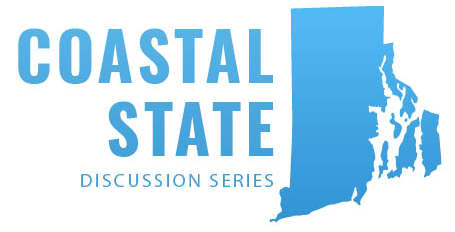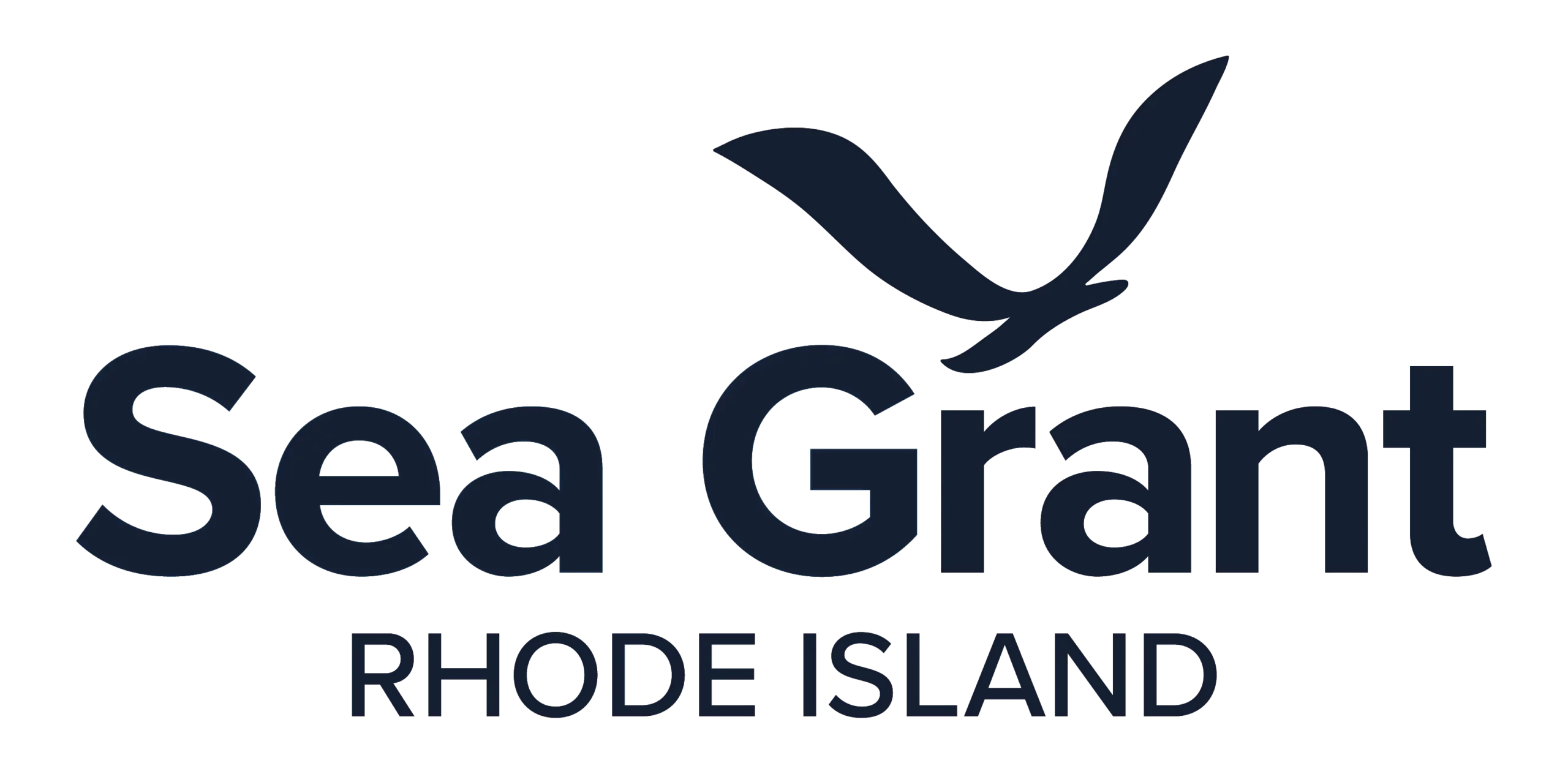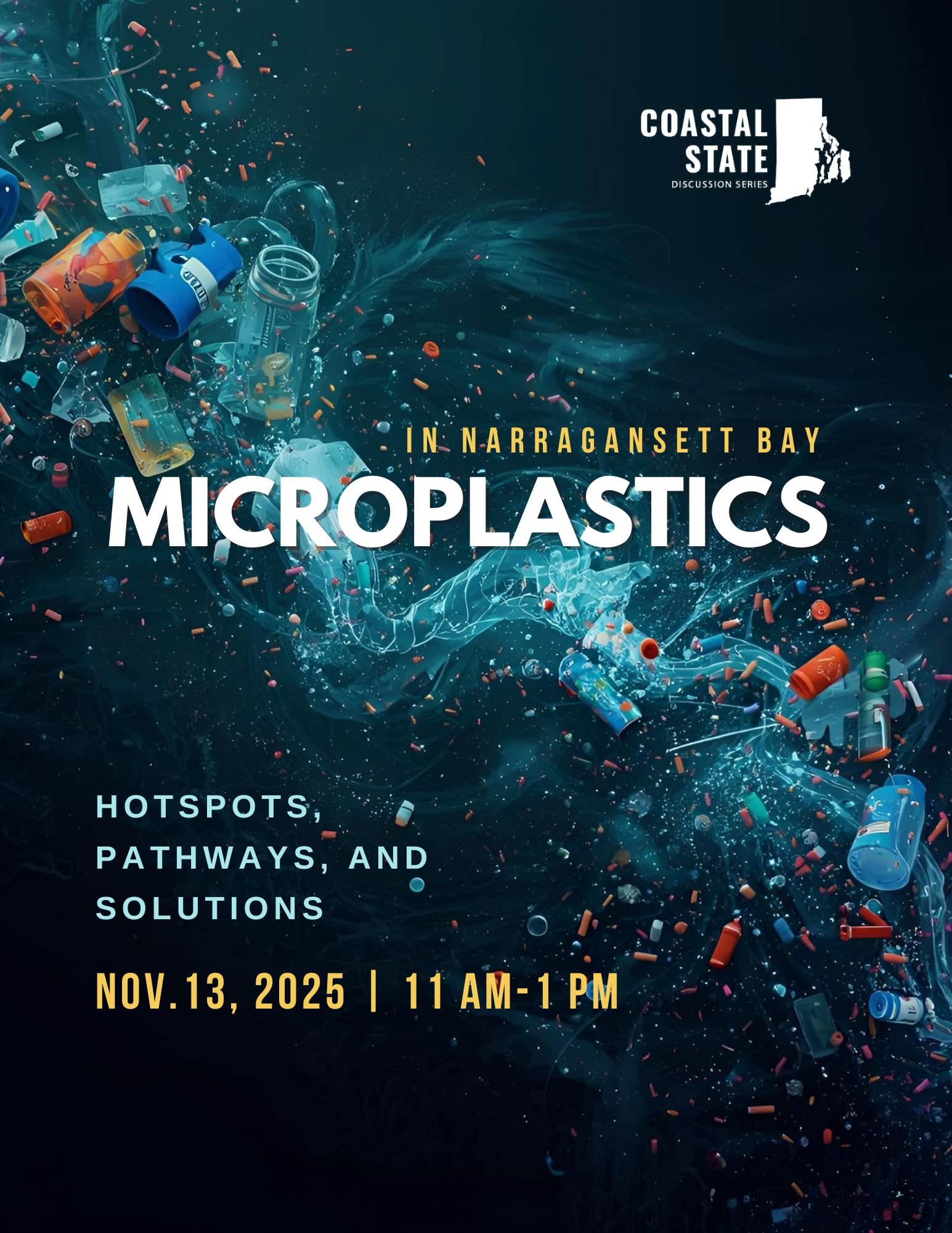Coastal State Series
Photo ©Jesse Burke
Current Events
Past events
About
The Coastal State Discussion Series is a public forum dedicated to highlighting current scientific research focused on marine issues impacting Rhode Island coastal communities and environments.
All events are free and all are encouraged to join!
#CoastalStateRI

Contact
For more information about this series, please contact Meredith Haas at mmhaas@uri.edu
Recent Events
Microplastics in Narragansett Bay
Hotspots, Pathways, and Solutions
Thursday, November 13 | 11 am–1 pm ET (Virtual)
Microplastics have become a defining pollutant of our time—now detected from polar ice cores to human bloodstreams. These fragments, fibers, and beads—smaller than five millimeters, often invisible to the naked eye—are created when everyday plastics break down from bags, bottles, textiles, and tires. Lightweight, durable, and nearly indestructible, they persist for decades, accumulating in rivers, estuaries, and oceans. Recent studies estimate that humans ingest tens of thousands of particles each year, while coastal ecosystems face mounting risks to food webs, water quality, and sediment health.
Until recently, scientists lacked a clear understanding of how these pollutants travel through estuaries like Narragansett Bay, or where they tend to accumulate.
This Coastal State Discussion explores recent research revealing where microplastics accumulate, how they move through coastal systems, and what that means for management and mitigation in Narragansett Bay and beyond.
SPEAKERS
Sarah Davis, Ph.D. (University of Rhode Island) will present findings from Rhode Island Sea Grant–funded research on microplastic distribution and transport in the Bay’s surface waters, examining how physical dynamics and watershed inputs shape concentrations across the estuary.
Victoria Fulfer, Ph.D. (5 Gyres Institute) will discuss microplastics in Bay sediments and broader patterns of contamination across coastal environments, linking local observations to national and global research and policy efforts.
Together, their work offers the most comprehensive look yet at microplastic pathways from watershed to seabed—and what it will take to protect coastal ecosystems from this pervasive pollutant.
In the Media
Past Events
Sea Urchin Farming
Often dubbed “porcupines of the sea” for their unique spines, sea urchins are in high demand globally for their roe, known as “uni,” which poses sustainability challenges for wild stocks as wild populations are declining due to overfishing and habitat loss.
As a luxury item with market prices up to $110 per kilogram, sea urchin farming is gaining attention as markets expand in the U.S. and Asia. In Rhode Island, shellfish and kelp farmers are growing interested in cultivating sea urchins, notably green and purple species, due to their compatibility with existing aquaculture operations.
Dr. Coleen Suckling of the University of Rhode Island and Dana Morse with Maine Sea Grant have been investigating how these species can be integrated into existing aquaculture operations and expand future operations. In Rhode Island, Suckling’s team has demonstrated the effectiveness of purple urchins in biofouling management, reducing maintenance costs and enhancing profitability. At a regional level, Suckling and Morse are investigating how to optimize hatchery production for green sea urchins to supply growers with an affordable seed stock.
A regional project led by Suckling and funded by the Northeastern Regional Aquaculture Center (NRAC) aims to optimize hatchery production for green sea urchins, ensuring regional growers have a steady supply of affordable seed stock. In collaboration with the University of Maine’s Center for Cooperative Aquaculture Research and Maine Sea Grant, the project will share technical support and best practices to help growers integrate sea urchin farming into existing operations.
“Urchin farming has generated a lot of interest in Maine, but nobody’s really nailed it down yet to where urchins are a profitable crop to grow,” says Morse, marine extension associate with Maine Sea Grant at the Darling Marine Center. “To allow us to take advantage of the creativity and ingenuity that prospective growers have, our best chance for developing economically viable systems is by providing reliable access to seed stock, and that’s where we are starting.”
Suckling and Morse will discuss their latest research and initiatives to bolster sea urchin aquaculture across New England, highlighting challenges and opportunities for the aquaculture industry to diversify operations through sustainable practices.
Co-sponsors: University of Rhode Island College of the Environment and Life Sciences & University of Maine/Maine Sea Grant
Multi-Use in RI Waters
The increasing utilization of Rhode Island’s coastal waters for activities such as fishing, recreation, renewable energy, and transportation poses new challenges for the shared use of limited space and resources.
To explore existing and potential multi-use opportunities, researchers David Bidwell (University of Rhode Island), Tiffany Smythe (University of Rhode Island), and Di Jin (Woods Hole Oceanographic Institution) conducted a study focusing on small business owners in sectors like commercial and recreational fisheries, aquaculture, marine education, tour operations, and other recreational uses such as surfing, kayaking, sailing, and boating.
Their findings illustrate ocean and coastal users’ multi-use experiences, highlighting small operators’ challenges in accessing and sustaining their roles within Rhode Island’s blue economy.
Researchers will also share potential future multi-use opportunities identified by users and their plans for examining these through the following research phase.
Co-sponsors: University of Rhode Island Department of Marine Affairs
Drivers of Toxic Blooms
Researchers across New England have been focused on better understanding a phytoplankton species known for producing domoic acid, a neurotoxin that can harm wildlife and humans, ever since an unprecedented harmful algal bloom in 2016 prompted the recall of more than five tons of shellfish in Maine and the first bay-wide precautionary closure for shellfishing in Rhode Island.
“An increase in bloom events and domoic acid production represents a significant risk to the state’s shellfish industry and local populations as domoic acid is responsible for amnesic shellfish poisoning,” says Dr. Matthew Bertin, who has been studying the production of cytotoxic compounds by harmful algal blooms for the last several years.
On December 12, Dr. Bertin, an expert in medicinal chemistry and chemical ecology at Case Western Reserve University and formerly URI, will discuss recent findings regarding the drivers of this particular phytoplankton species in Narragansett Bay and implications for future blooms. The Bertin laboratory’s work has shown distinct seasonal maxima of domoic acid that is the likely result of toxin-producing species assemblages. Additionally work has shown that there is likely episodic introduction of certain species to the bay including P. australis, which is a species of concern due to its high capacity for toxin production. The newest research implicates nutrient limitation as a trigger for toxin production, though this research is ongoing.
“This information will be valuable to resource managers and stakeholders in order to forecast times when domoic acid is at its highest concentration in Narragansett Bay and to establish a robust time series data set that can set the stage for further forecasting of blooms and toxin production. Additionally, determination of toxin triggers will result in mitigation strategies that will serve the shellfishing community and the general public.”
Changes in the Benthos
Estuary ecosystems are some of the most complex, where freshwater meets saltwater, creating a mosaic of habitats essential for commerce, recreation, and fishing. These ecosystems have adapted to this duality, but how they have and will respond to changes in activities along the coast, rising seas, and warming temperatures is unknown.
Researchers at the University of Rhode Island and The Nature Conservancy are looking to better understand these changes by studying the benthic ecosystem of the seafloor across Narragansett Bay. This ecosystem plays a major role in water filtration, nutrient cycling, shoreline buffering, food and habitat for fishes and birds, and seafood for human consumption. It is also a historical archive of ecological changes in the Bay.
Dr. Jeremey Collie from the University of Rhode Island’s Graduate School of Oceanography, along with GSO graduate Shaina Harkins and Heather Kinney from TNC, will share their research looking into how changes in temperature and water quality have affected benthic biodiversity in the Bay over the last several decades. This includes investigating whether the state’s nitrogen reduction efforts from wastewater treatment facilities have been practical, which have long been considered the primary cause of nutrient over-enrichment linked to harmful algal blooms and hypoxic events.
Co-sponsors: University of Rhode Island Graduate School of Oceanography and The Nature Conservancy
Disease-Resistant Oysters
Scientists are investigating how, and if, oysters can be bred for disease resistance or disease tolerance and what that could mean for a multi-million dollar industry and the coastal environment.
The U.S. eastern oyster aquaculture industry is rapidly expanding with a value that has increased over 10-fold in some Atlantic states in the last 15 years. In addition to their economic value, oysters also provide tremendous ecosystem services and are the focus of intensive restoration efforts.
However, commercial seed for farms or restoration is limited to specific environments and vulnerable to disease. Changes in the climate are also expected to further enhance these vulnerabilites and limitations.
Sea Grant funded-researchers discuss their ongoing work investigating the viability of breeding disease-resistant or disease-tolerant oysters, and what that might mean for coastal marine ecosystems.
This free webinar is part of the annual Coastal State Discussion Series hosted by Rhode Island Sea Grant and co-sponsored by the University of Rhode Island’s College of Environment and Life Science.
A New Narragansett Bay
Scientists have touted Narragansett Bay as the cleanest it has been in 150 years—a long journey to restoration from its history as a dumping ground for toxic metals, sewage, and other pollutants since the Industrial Revolution.
With improvements in wastewater treatment facilities and controlling storm runoff, Rhode Island has exceeded its goal of a 50% reduction in nitrogen. Nitrogen reduction has been a steadfast focus for the state in cleaning up the Bay to reduce harmful algal blooms that lead to low dissolved oxygen levels, which can lead to fish kills, such as occurred in 2003 in Greenwich Bay. And while there are many nitrogen sources, wastewater facilities have been identified as the primary source in Narragansett Bay.
However, some critics say that reducing nitrogen has made the bay “too clean” by reducing the amount of an important food source of phytoplankton that supports local fisheries.
How the Bay will fully respond to reduced levels of nitrogen with the addition of warming waters is still unknown. “We need to watch trends of [secondary impacts],” says Dr. Candace Oviatt, a professor of oceanography at the University of Rhode Island’s Graduate School of Oceanography.
Oviatt and her colleagues have been exploring these changes in nitrogen loading into the bay and the secondary impacts of warming waters over the last several years to provide managers with a clearer picture of the changing trends in the timing and availability of nitrogen in Narragansett Bay. This will help resource managers forecast and understand the bay’s changes, such as harmful algal bloom dynamics or fisheries resources (e.g., shellfish).
Oviatt will be joined by URI Masters student Michael Potter II and Dr. Robinson Fulweiler from Boston University as part of the Coastal State Discussion webinar series to share current research findings and plans for ongoing research.
—–
+ URI Researcher Proposes Limited Return of Nutrients to Narragansett Bay
Marine Plastic
Today, almost everyone in the world comes into contact with plastics daily. These plastics are lightweight, durable, inexpensive, and easily modified, making them the ubiquitous material of the modern economy. However, in 2017 alone, ~348 million tons of plastics were produced worldwide, and production is expected to triple by 2050. The U.S. recovers less than 10% of its annual plastic production, and it is the fastest-growing component of municipal waste.
Nearly 85% of all marine debris is plastic, and all studied ecosystems on Earth have been found to contain plastics. With a growing demand for plastics, there remain simple questions:
What do we do with this waste?
What can we replace it with?
What impacts do plastics have on human and environmental health?
Over the last several years, researchers at the University of Rhode Island have been characterizing marine plastic pollution in various habitats.
Speakers Dr. Andrew Davies and Dr. Coleen Suckling, along with Ph.D. candidate Sara Davis, discussed their work exploring the distribution of plastics, including microplastics, within the surface waters of Narragansett Bay. They shared the challenges in characterizing microplastics within complex marine habitats and show early research findings as they aim to produce the first robust estimates of microplastics within Rhode Island’s coastal waters.
—
+ URI researchers identify links between climate crisis and plastics pollution
Detecting HABs
Alfred Hitchcock’s famous film The Birds was inspired by a bizarre event in Monterey Bay in 1961 when crazed birds were seen crashing into buildings, cars, and street signs. The culprit: domoic acid, a neurotoxin produced by a specific species of phytoplankton that, if ingested, can cause animals to become disoriented or have seizures. In humans, it can also cause seizures, short-term memory loss, or worse in severe cases.
In 2016, an unprecedented harmful algal bloom with detectable levels of domoic acid spanned across New England, prompting a recall of over 5 tons of potentially infected shellfish in Maine and the first-ever bay-wide closure for shellfishing in Rhode Island as a precaution, although toxicity never reached harmful levels. The presence of domoic acid also led to another closure of shellfish harvesting in Narragansett Bay the following year. The cause of these events remains unknown, and the implications for local economies and human health prompted research to understand better and monitor Pseudo-nitzschia, the genus of plankton responsible for producing domoic acid.
“Pseudo-nitzschia has been detected for over 50 years in the Narragansett Bay Long-Term Plankton Time Series but has only been a problem recently,” says Dr. Bethany Jenkins, associate professor of cellular and molecular biology at the University of Rhode Island. “What caused these events is unknown: whether an environmental factor altered the physiology of endemic Pseudo-nitzschia or new toxin-producing strain(s) were introduced.”
Speakers Dr. Bethany Jenkins, associate professor and marine microbial ecologist, and Ph.D. candidate Alexa Sterling from the University of Rhode Island, as well as Dr. Colleen Mouw, associate professor at URI’s Graduate School of Oceanography, will discuss their research investigating the various strains of Pseudo-nitzschia and real-time characterization of phytoplankton communities in Narragansett Bay that allows for a rapid field response to target harmful algal bloom events as they occur.
This free webinar is part of the annual Coastal State Discussion Series hosted by Rhode Island Sea Grant and co-sponsored by the Rhode Island EPSCoR C-AIM Consortium, the University of Rhode Island’s College of Environment and Life Science, and University of Rhode Island Graduate School of Oceanography.
—
Coastal Megaprojects
Rhode Island is long overdue for a major hurricane. Even a brush with Superstorm Sandy in 2012, which caused $11.2 million in damages and left 122,000 Rhode Islanders without power, was not a worst-case scenario, but a reminder of our exposure and vulnerability. And a record-setting hurricane season in 2020 with 30 named storms, 12 of which made landfall in the U.S., was another reminder of how a changing climate makes rising seas and storm-flooding more devastating.
Storm surge barriers, levees, and other coastal flood protection megaprojects are being investigated as strategies to protect U.S. cities against devastating coastal storms and rising sea levels. But these projects are large-scale and complex, often taking years to decades to complete and costing billions of dollars with long-lasting impacts on the economy, environment, and society. Additional layers of social conflict and other political factors also cast doubt on their status as practical climate adaptation options.
Dr. Paul Kirshen, professor of climate adaptation at the University of Massachusetts Boston, and Dr. D.J. Rasmussen, an engineer and climate scientist who recently graduated from Princeton University’s School of Public Policy & International Affairs, will discuss the technical, environmental, economic, and political factors of why some coastal flood protection megastructures break ground in the U.S. while others do not, using Boston Harbor and Rhode Island’s Fox Point Hurricane Barrier in Providence–the first gated hurricane-protection structure in the U.S.– as case studies.
This free webinar is part of the annual Coastal State Discussion Series hosted by Rhode Island Sea Grant and co-sponsored by the University of Rhode Island’s Coastal Institute, Marine Affairs Department, and The Policy Lab at Brown University.
—
HABs and New Drug Discoveries
An unprecedented harmful algal bloom that spanned from Long Island to Maine in 2016 prompted a recall of over 5 tons of potentially infected shellfish in Maine and the first-ever bay-wide closure for shellfishing in Rhode Island.
Researchers across the region have since been focused on better understanding the species that drive harmful blooms and the types of toxins they produce, such as domoic acid, which is a that can infect shellfish and be harmful to consumers.
Rhode Island Sea Grant hosted a virtual Coastal State Discussion led by Dr. Matthew Bertin, an assistant professor in the Department of Biomedical and Pharmaceutical Sciences at the University of Rhode Island, who discussed ongoing work investigating why these organisms produce harmful toxins and how these compounds can be leveraged into potential drug leads for either treatment of the disease or new drugs.
“The 2016 event and the continued detection of domoic acid in the bay suggest that either species composition has shifted to more toxic strains of these species, or environmental conditions have made resident species more toxic,” says Bertin. “An increase in bloom events and domoic acid production represents a significant risk to the state’s shellfish industry and local populations as domoic acid is responsible for amnesic shellfish poisoning.”
In addition to studying the human and environmental impact of toxins such as domoic acid, Bertin and his colleagues have also been studying two cyanobacterial communities, Microcystis and Trichodesmium, in a search for new therapeutic lead molecules that could treat neuroinflammation, which is a driver in diseases such as Alzheimer’s.
“In four years, we have discovered over 30 new-to-science molecules, many with promising biological activities,” he says.
—

